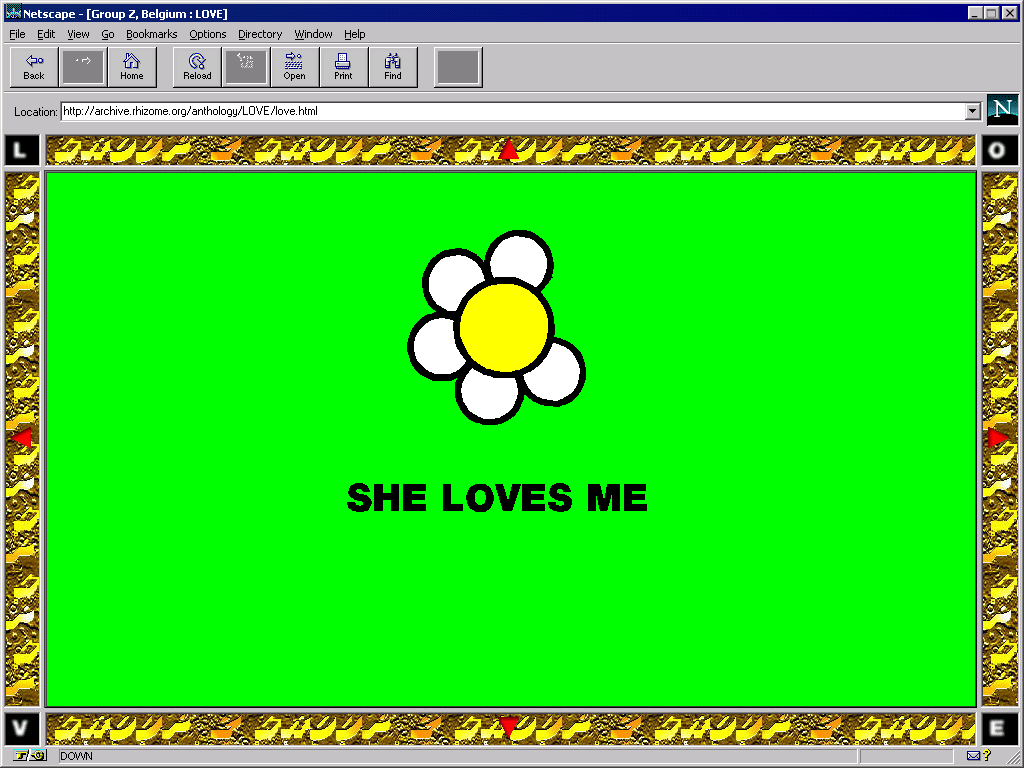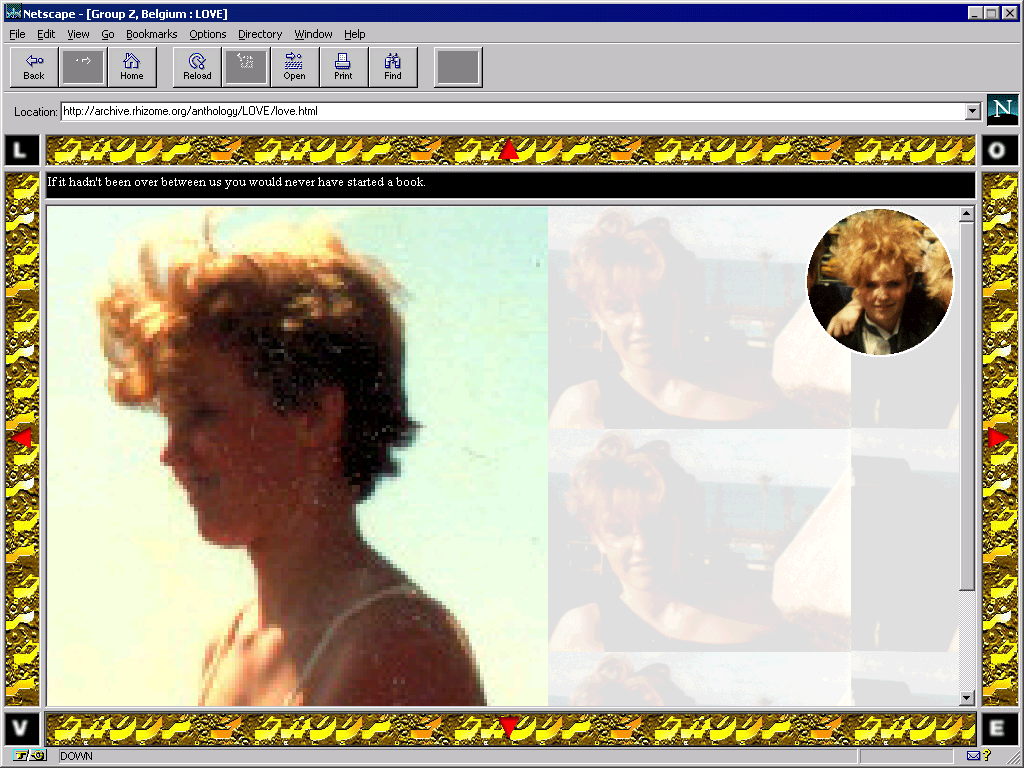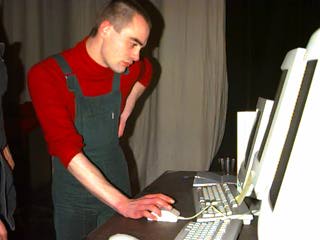This essay accompanies the presentation of Group Z, Belgium's LOVE as a part of the online exhibition Net Art Anthology.
Michael Connor: So, who was Group Z?
Michaël Samyn: It was a pretend collective of artists. I was making analog art in my studio; I wanted to have a gallery show or something like that, but the response that people had was that my work wasn’t consistent enough, and I felt that too. You know, other artists, they made the same thing year after year…
So I invented this collective of artists—ten artists. They each had a certain style or imagery to make it seem more acceptable. And so the whole thing was sort of presented as a company, a production company. Each work had a title but it also had a catalog number. And I photocopied these catalogs with prices and everything, dimensions, prices, everything like that.
MC: Was it ever your intent to fool people into thinking they were real? Or were they presented as a conceit?
MS: I never told anyone that it wasn’t true, and some people might assume that it was true. Why would they question...it’s not like this is very public either, I mean with the analog work maybe thirty or forty people ever heard about this, just in my hometown.
MC: How did the relationship with äda‘web come about? Did you start the work as a commission? Or was it already in progress?
When we started, people had their own computers and we were happy that we could log in and actually have access to the internet. But to have a server—that was special. It was difficult to get a place where you could have your work be stored permanently. I think at some point I was also working with a local group here doing cultural things with the internet, and I think there was an IRC session at some point, where Benjamin Weil was also present. It was very informal, “Okay, I need web space.” “Okay! Upload it, put it online.” They even helped me with some technical things.

Group Z, Belgium (Michaël Samyn), LOVE, 1995, as seen via Netscape 2.0 in oldweb.today.
MC: One aspect of LOVE that stands out to me is the grid structure.
MS: The grid is just an underlying structure, you’re supposed to navigate it with the little arrows on the side. Though you still navigate it left, right, up, down, like a table.
MC: It’s kind of difficult to navigate it in a truly nonlinear way. Like usually you have the flower, and then the three people, and then the Marquis de Sade…
MS: Yes, if you keep pressing on the same side, top bottom left or right, you’ll always have that same order. Those series are logically arranged. I think there’s a diagonal somewhere where it always ends—it’s difficult to avoid hitting that diagonal. When you reach the image that says “The End,” you can’t proceed. You always go back to the first.
MC: Another thing that strikes me as unusual about the work is that it was so image heavy. You have all these places where you layer, for example, a GIF with a transparent background on top of a tiled JPEG, which adds visual depth without taking up much bandwidth.
MS: Tiling was of course a huge tool for that. There was the aspect, of course, of wanting to create a rich graphic on the web page, but there was also not knowing how big the browser window would be. In LOVE I demand a sort of minimum resolution, but I wanted it to be flexible, there didn’t need to be a certain kind of rectangle or anything, so tiling was very useful for that. You could tile endlessly, filling up the space with imagery without having to download more.
And I guess, given the grid structure of the work, I kind of like patterning anyway. So it wasn’t a big sacrifice.
MC: Many of the images in LOVE appear to be found. Can you talk about the kinds of sources you drew on?
MS: Most of the images come from a huge collection that I kept from pages of magazines. I just tore out things. It’s sort of like images that I found interesting and then after awhile I’d see correlations, like, oh, these kinds of images belong together.
Those are part of the series in LOVE, when this certain theme in advertising becomes apparent. I find it amusing to attribute more depth to an advertising picture than was intended in the picture originally.
But yeah, mostly paper. Scanned in from paper. At the time the internet didn’t have such an easily accessible image search function or anything like that. Actually the internet had very little advertising in 1995. And pictures had very low resolution.
MC: What about the porn images?
MS: [The web] was also very primitive back then. I think they must have come from CD-ROMs, and I won't research them either. But I suggested you do a reverse Google image search.
[Interviewer’s note: a reverse Google image search proves fruitless.]
MC: You mentioned that a particular theme from advertising becomes apparent in the work. Can you tell me more about that?
MS: Yeah, like patterns in certain advertising photography. A threesome in those days—I guess it was sort of left over from the ’80s in a way, that yuppie style—that was like a theme, in fashion photography. There was probably no reason for it but it suddenly became kind of weird when you started noticing it.

Group Z, Belgium (Michaël Samyn), LOVE, 1995, as seen via Netscape 2.0 in oldweb.today.
MC: I think that’s one of the tensions in the piece, there’s an uneasy balance between parts of it that feel really sincere and parts that feel more cynical about love.
MS: I don’t know if it’s even cynical. It’s trying to be open to different aspects of love, not necessarily as a person but just as an artist, as a sort of presentation. In some places, love is this intimate thing you share with another person by candlelight, and then in other cases, the candle might be used for whole other purposes, like in de Sade or something. All of these things are related to that concept of...I mean, maybe it’s not love, but at least that thing that people do with each other for emotional reasons.
MC: I was interested also in the way you framed it in the beginning—you were careful to say that the work narrates love from a heterosexual perspective.
MS: After I made it, I said, yeah, well, hey, I’m trying to be kind of open about this but ultimately I only have my own experience. And I didn’t mean it to be just about me or my experience.
MC: There are a lot of works from this time that we see as being critical of net culture or thinking about software, but this piece feels sort of—much more—personal.
MS: Well, it’s not that it’s more personal or more impersonal in a way. I think it’s the modernist tradition to make art about art. Paintings that are about paintings... It’s a very modernist attitude and I’ve always felt uncomfortable with modernism anyway. Even if this medium is highly technological and we can hardly pretend that the computer isn’t there and the network isn’t there, I still don’t think that that means that the art need to be about that or deal with that.
It is important to be critical and engage with your medium, but very often I think that artists use that to keep a distance, to not have to learn how to use a medium, for instance, or to not have to try to make something beautiful and to take some kind of high throne and declare that this is commercial shit or this is dangerous to society. It seems a bit easy sometimes, to me, to do that.
Lately I sort of also feel that—and maybe that played a part then on a more functional level—that artist have to sacrifice their own ethics. I don’t think that you can make borders [as an artist] that you won’t allow yourself to cross. And that probably played a part back then too; now it is just more clear to me.
MC: How is it it more clear to you now?
MS: In the mid ’90s there was sort of the feeling of openness, of a lot of possibility, a lot of things that could change. Now I think that it’s kind of the opposite. Now there is a general feeling of being stuck and nothing can change. You’re very very limited in what you’re allowed to say, for fear of being attacked.
MC: Is this about how you recently left the gaming industry, and came under attack from trolls? [Samyn and his partner Auriea Harvey founded games studio Tale of Tales in 2002, and decided in 2015 to shift their focus away from commercial videogames.]
MS: I wasn’t even thinking about that but yes, indeed. And that is very much related to saying and speaking, very much. The attacks started when I said something, sort of in the context of—I was talking with another person on Twitter, and it was just right after we decided to stop making commercial games, and we were sort of rejoicing, like now I can say whatever i want and what I couldn’t say for years because it was bad for commercial sales.
And so I demonstrated that to this person, and I said look I can say, “Fuck gamers! Fuck the game industry!” And sure enough for like two weeks or something, we were attacked by GamerGate; every morning I had to wake up and block thirty to forty accounts, because it was like constantly—because they took this seriously. I mean, for one thing, I meant what I said seriously in a way. But on the other hand, it was in the context of a conversation. But the funny thing is that they attacked; they all pretended to think it was real. So it proved that I was right, you know, to think that in the gaming industry one cannot speak. It was a very strange situation.
But yeah, it’s not fun. From a distance, it look like amusing chaos. Even though you don’t respect the people who sort of start insulting you, it’s still not a pleasant thing. And I know there are people who’ve been attacked a lot worse than we were.
I think it contributed to, or solidified, our decision to not be involved with games anymore.
MC: So where does that put you right now, if not in commercial games? Are you working as artists more?
MS: Yeah, I mean we were always working as artists, but within games it’s limited in a way. There’s a certain format, there’s a certain audience, there’s a certain way of distributing things. And not that, you know, people still got a lot out of our work. But after a while we felt that it was limiting us. Like we were getting more and more ideas, that were like, “nah, we can never get away with that in a game,” or something like that; or, “nobody will want to play this.” And I think that that’s where we are now, where we can just engage with these ideas that don’t fit anywhere. And try and do something with it and not pretend that we’re going to sell thousands of copies with it and fund the production through that. Because that’s not going to happen anyway, and it allows us to work in a different way.

Michaël Samyn, 1995.
MC: Sometimes people talk about the ’90s net art scene in a way that evokes a sense of trauma—friendships falling apart through arguments or critical attacks from the outside, losing support. Did you have any kind of experience of a moment where net art was cohesive as a scene, and then having it fall apart after that?
MS: I might not have been social enough to experience what you’re talking about. For me it was mostly the way that the internet grew and became attractive to commercial corporations and they just turned it into something that they could make money from. Which I remember, laughing at the time when I was working as a designer, like everybody’s investing in the internet but nobody’s making any money but me as a web designer! But then they found a way; and that made the environment a lot less interesting to show art in and that was definitely one of the key motivations to move to games for us.
But I felt that sense very little among artists, I must say. Mostly more among critics and philosophers, which often struck me as kind of technophobic. They often came from a very negative kind of—I’m not gonna say Luddite, because they were savvy enough to know what was going on—but they were very, you know….maybe that’s what is called “critical,” I don’t know...
Maybe the artists were overly optimistic. It was really an almost euphoric time to be an artist. Before that, you know, you were making work and kissing the asses of gallerists and hoping to god that you would ever show your work in a museum. And maybe, maybe they would buy a piece of yours. And the internet came along and was like, “Fuck all that!!!!” [laughs]. “I’m just gonna make my work, put it on the internet, and people will see it, and you know what like ten thousand times more people will see it than would ever visit your gallery, so fuck you.” So it was very sort of optimistic feeling among artists, that they could control their own creative lives.


